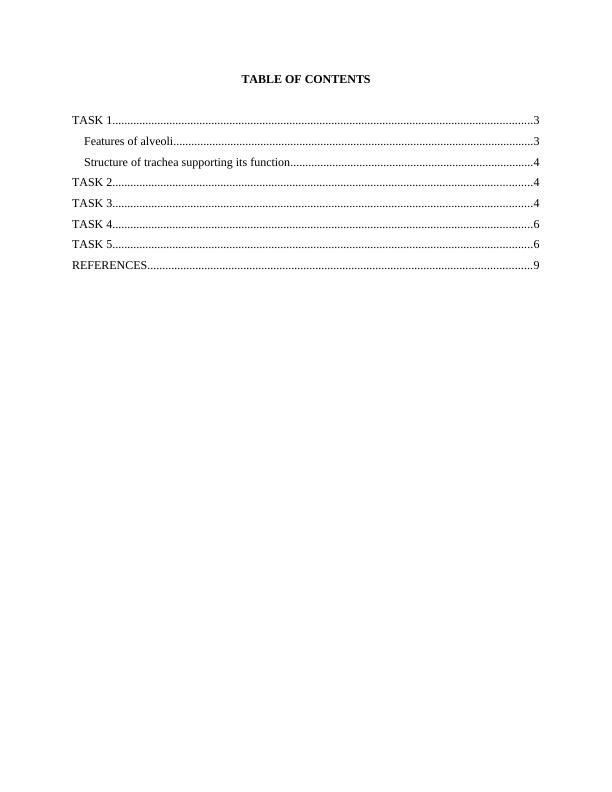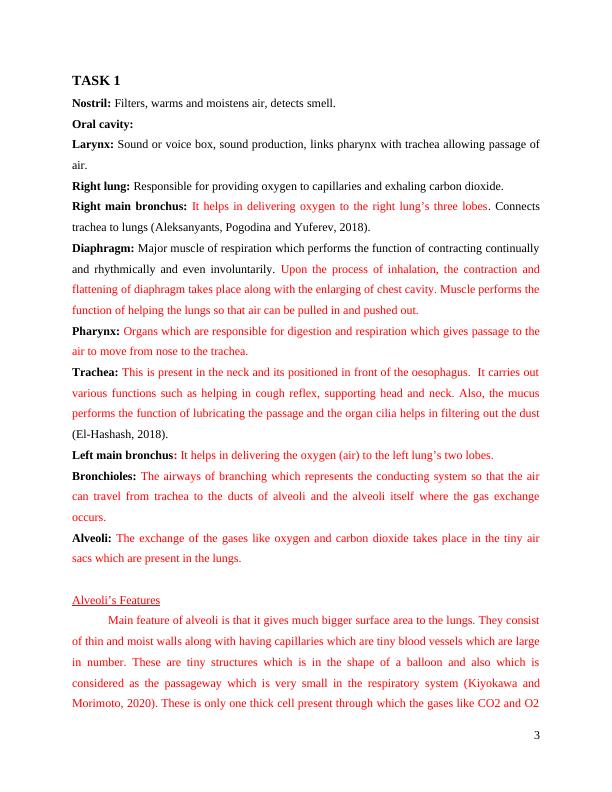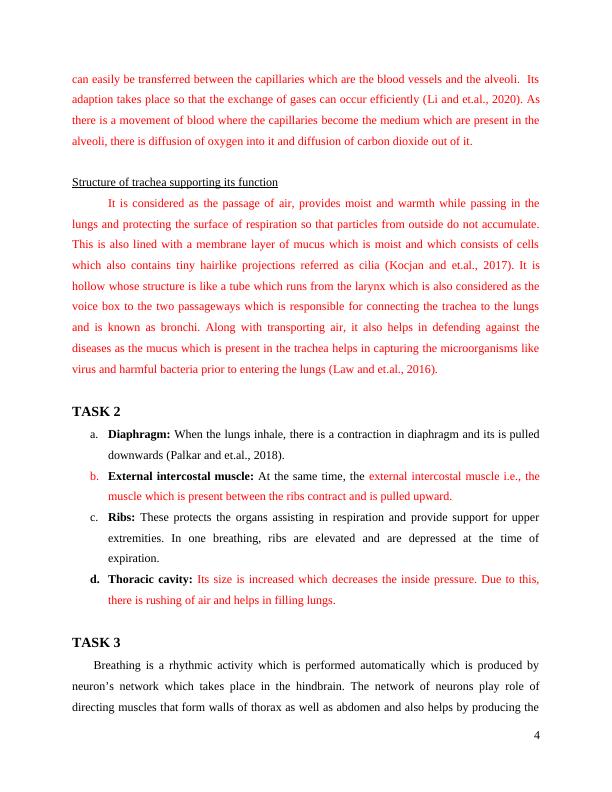Human biology
11 Pages2544 Words89 Views
Added on 2023-01-03
Human biology
Added on 2023-01-03
ShareRelated Documents

TABLE OF CONTENTS
TASK 1............................................................................................................................................3
Features of alveoli........................................................................................................................3
Structure of trachea supporting its function.................................................................................4
TASK 2............................................................................................................................................4
TASK 3............................................................................................................................................4
TASK 4............................................................................................................................................6
TASK 5............................................................................................................................................6
REFERENCES................................................................................................................................9
TASK 1............................................................................................................................................3
Features of alveoli........................................................................................................................3
Structure of trachea supporting its function.................................................................................4
TASK 2............................................................................................................................................4
TASK 3............................................................................................................................................4
TASK 4............................................................................................................................................6
TASK 5............................................................................................................................................6
REFERENCES................................................................................................................................9

TASK 1
Nostril: Filters, warms and moistens air, detects smell.
Oral cavity:
Larynx: Sound or voice box, sound production, links pharynx with trachea allowing passage of
air.
Right lung: Responsible for providing oxygen to capillaries and exhaling carbon dioxide.
Right main bronchus: It helps in delivering oxygen to the right lung’s three lobes. Connects
trachea to lungs (Aleksanyants, Pogodina and Yuferev, 2018).
Diaphragm: Major muscle of respiration which performs the function of contracting continually
and rhythmically and even involuntarily. Upon the process of inhalation, the contraction and
flattening of diaphragm takes place along with the enlarging of chest cavity. Muscle performs the
function of helping the lungs so that air can be pulled in and pushed out.
Pharynx: Organs which are responsible for digestion and respiration which gives passage to the
air to move from nose to the trachea.
Trachea: This is present in the neck and its positioned in front of the oesophagus. It carries out
various functions such as helping in cough reflex, supporting head and neck. Also, the mucus
performs the function of lubricating the passage and the organ cilia helps in filtering out the dust
(El-Hashash, 2018).
Left main bronchus: It helps in delivering the oxygen (air) to the left lung’s two lobes.
Bronchioles: The airways of branching which represents the conducting system so that the air
can travel from trachea to the ducts of alveoli and the alveoli itself where the gas exchange
occurs.
Alveoli: The exchange of the gases like oxygen and carbon dioxide takes place in the tiny air
sacs which are present in the lungs.
Alveoli’s Features
Main feature of alveoli is that it gives much bigger surface area to the lungs. They consist
of thin and moist walls along with having capillaries which are tiny blood vessels which are large
in number. These are tiny structures which is in the shape of a balloon and also which is
considered as the passageway which is very small in the respiratory system (Kiyokawa and
Morimoto, 2020). These is only one thick cell present through which the gases like CO2 and O2
3
Nostril: Filters, warms and moistens air, detects smell.
Oral cavity:
Larynx: Sound or voice box, sound production, links pharynx with trachea allowing passage of
air.
Right lung: Responsible for providing oxygen to capillaries and exhaling carbon dioxide.
Right main bronchus: It helps in delivering oxygen to the right lung’s three lobes. Connects
trachea to lungs (Aleksanyants, Pogodina and Yuferev, 2018).
Diaphragm: Major muscle of respiration which performs the function of contracting continually
and rhythmically and even involuntarily. Upon the process of inhalation, the contraction and
flattening of diaphragm takes place along with the enlarging of chest cavity. Muscle performs the
function of helping the lungs so that air can be pulled in and pushed out.
Pharynx: Organs which are responsible for digestion and respiration which gives passage to the
air to move from nose to the trachea.
Trachea: This is present in the neck and its positioned in front of the oesophagus. It carries out
various functions such as helping in cough reflex, supporting head and neck. Also, the mucus
performs the function of lubricating the passage and the organ cilia helps in filtering out the dust
(El-Hashash, 2018).
Left main bronchus: It helps in delivering the oxygen (air) to the left lung’s two lobes.
Bronchioles: The airways of branching which represents the conducting system so that the air
can travel from trachea to the ducts of alveoli and the alveoli itself where the gas exchange
occurs.
Alveoli: The exchange of the gases like oxygen and carbon dioxide takes place in the tiny air
sacs which are present in the lungs.
Alveoli’s Features
Main feature of alveoli is that it gives much bigger surface area to the lungs. They consist
of thin and moist walls along with having capillaries which are tiny blood vessels which are large
in number. These are tiny structures which is in the shape of a balloon and also which is
considered as the passageway which is very small in the respiratory system (Kiyokawa and
Morimoto, 2020). These is only one thick cell present through which the gases like CO2 and O2
3

can easily be transferred between the capillaries which are the blood vessels and the alveoli. Its
adaption takes place so that the exchange of gases can occur efficiently (Li and et.al., 2020). As
there is a movement of blood where the capillaries become the medium which are present in the
alveoli, there is diffusion of oxygen into it and diffusion of carbon dioxide out of it.
Structure of trachea supporting its function
It is considered as the passage of air, provides moist and warmth while passing in the
lungs and protecting the surface of respiration so that particles from outside do not accumulate.
This is also lined with a membrane layer of mucus which is moist and which consists of cells
which also contains tiny hairlike projections referred as cilia (Kocjan and et.al., 2017). It is
hollow whose structure is like a tube which runs from the larynx which is also considered as the
voice box to the two passageways which is responsible for connecting the trachea to the lungs
and is known as bronchi. Along with transporting air, it also helps in defending against the
diseases as the mucus which is present in the trachea helps in capturing the microorganisms like
virus and harmful bacteria prior to entering the lungs (Law and et.al., 2016).
TASK 2
a. Diaphragm: When the lungs inhale, there is a contraction in diaphragm and its is pulled
downwards (Palkar and et.al., 2018).
b. External intercostal muscle: At the same time, the external intercostal muscle i.e., the
muscle which is present between the ribs contract and is pulled upward.
c. Ribs: These protects the organs assisting in respiration and provide support for upper
extremities. In one breathing, ribs are elevated and are depressed at the time of
expiration.
d. Thoracic cavity: Its size is increased which decreases the inside pressure. Due to this,
there is rushing of air and helps in filling lungs.
TASK 3
Breathing is a rhythmic activity which is performed automatically which is produced by
neuron’s network which takes place in the hindbrain. The network of neurons play role of
directing muscles that form walls of thorax as well as abdomen and also helps by producing the
4
adaption takes place so that the exchange of gases can occur efficiently (Li and et.al., 2020). As
there is a movement of blood where the capillaries become the medium which are present in the
alveoli, there is diffusion of oxygen into it and diffusion of carbon dioxide out of it.
Structure of trachea supporting its function
It is considered as the passage of air, provides moist and warmth while passing in the
lungs and protecting the surface of respiration so that particles from outside do not accumulate.
This is also lined with a membrane layer of mucus which is moist and which consists of cells
which also contains tiny hairlike projections referred as cilia (Kocjan and et.al., 2017). It is
hollow whose structure is like a tube which runs from the larynx which is also considered as the
voice box to the two passageways which is responsible for connecting the trachea to the lungs
and is known as bronchi. Along with transporting air, it also helps in defending against the
diseases as the mucus which is present in the trachea helps in capturing the microorganisms like
virus and harmful bacteria prior to entering the lungs (Law and et.al., 2016).
TASK 2
a. Diaphragm: When the lungs inhale, there is a contraction in diaphragm and its is pulled
downwards (Palkar and et.al., 2018).
b. External intercostal muscle: At the same time, the external intercostal muscle i.e., the
muscle which is present between the ribs contract and is pulled upward.
c. Ribs: These protects the organs assisting in respiration and provide support for upper
extremities. In one breathing, ribs are elevated and are depressed at the time of
expiration.
d. Thoracic cavity: Its size is increased which decreases the inside pressure. Due to this,
there is rushing of air and helps in filling lungs.
TASK 3
Breathing is a rhythmic activity which is performed automatically which is produced by
neuron’s network which takes place in the hindbrain. The network of neurons play role of
directing muscles that form walls of thorax as well as abdomen and also helps by producing the
4

End of preview
Want to access all the pages? Upload your documents or become a member.
Related Documents
Structure and Function of the Respiratory Systemlg...
|19
|3797
|442
Role of Respiratory Systemlg...
|15
|1097
|17
Human Physiology Assignment- Respiratory Systemlg...
|9
|2071
|150
Human Respiratory and Cardiac Systems Essaylg...
|15
|3951
|45
Respiratory Systemlg...
|16
|2909
|483
Human Respiratory & Cardiac System Essaylg...
|8
|2480
|258
